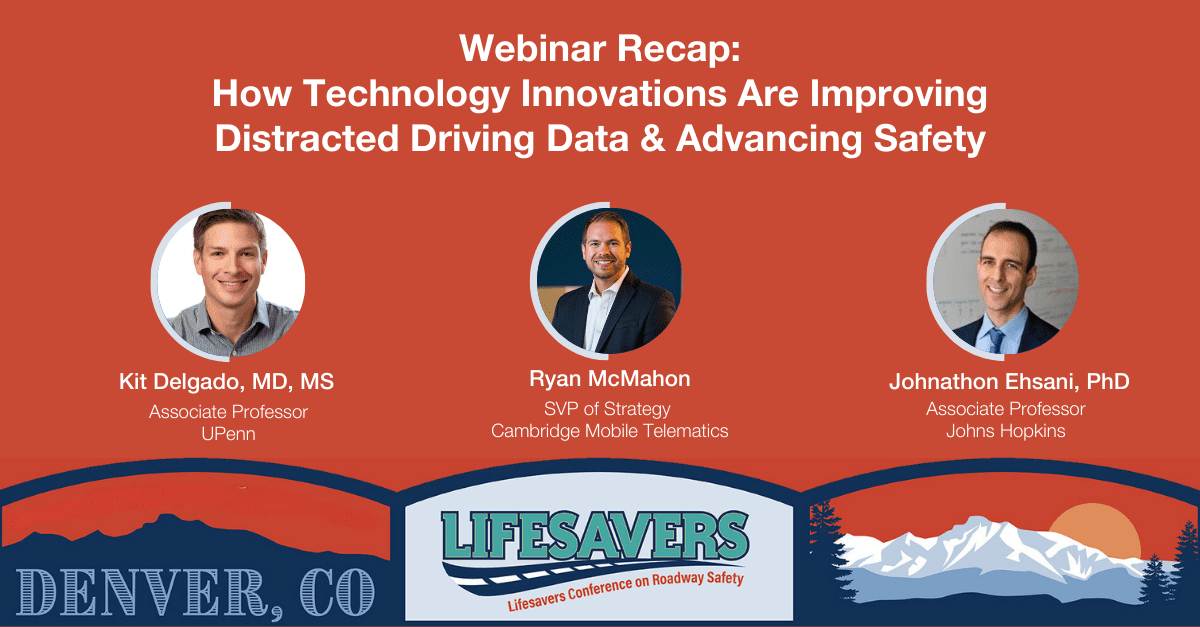Webinar Recap: How Technology Innovations are Improving Distracted Driving Data & Advancing Safety

Distracted driving has been a deadly hazard on American roadways for over a decade. The National Highway Traffic Safety Administration (NHTSA) estimates that nearly 30% of all crashes are due to distraction. Based on this estimate, distracted driving caused over 12,000 fatalities in 2021. Safety officials have struggled to lower distraction in their communities for years. Now, telematics programs are paving a new way forward for road safety by engaging, coaching, and rewarding drivers.
CMT recently spoke at the Lifesavers Conference on Roadway Safety. Ryan McMahon, SVP of Strategy at CMT, joined a panel discussion on how telematics is helping drivers reduce risky driving behaviors, like distraction, speeding, acceleration, and hard braking. They dove into the behavioral economics behind what motivates drivers to change behavior.
The discussion featured behavioral experts: Dr. Johnathon Ehsani of Johns Hopkins Bloomberg School of Public Health, and Dr. Kit Delgado of Penn’s Perelman School of Medicine.
The discussion was live-streamed as a special episode of the Travelers Institute Wednesdays with Woodward® webinar series.
Check out the full webcast here.
The panel kicked off by providing context on telematics, how it helps drivers improve their driving, and how it helps road safety professionals identify unsafe drivers.
Dr. Ehsani described telematics as a monumental breakthrough in understanding driver risk.
“Telematics is an innovation in measurement. It’s a little bit akin in the road safety world to the invention of going from eyeballing a Petri dish to having a microscope,” said Dr. Ehsani.
One of the main takeaways from the discussion was that frequent safe driving rewards help reduce distracted driving, a finding backed by behavioral studies.
Dr. Kit Delgado spoke about a study by CMT, the University of Pennsylvania, and a top US carrier that examined the effectiveness of safe driving incentives and driver feedback. The U.S. Department of Transportation and the Federal Highway Administration published the results.
The study explored the power of rewards, frequency, and framing for behavior change. It found that offering small weekly rewards for safe driving and withholding rewards for highly distracted drivers makes drivers 2X safer — compared to traditional long-term incentives like annual insurance premium discounts.
“We found that the same amount of money [can make] twice the impact just from delivering rewards more frequently. So this tells us that frequent rewards and feedback drive behavior change. You don’t have to change the overall discount amount—that $4 billion that’s being paid out right now in terms of discounts [just needs to be used] smarter. Also contributing to that is framing things in terms of a loss, showing people how much money they’re losing as time goes on from not changing their behavior,” Dr. Delgado.
Dr. Delgado went on to discuss how contests can drive positive, lasting behavior change. In the study, drivers with similar risk profiles competed to see who was the safest driver each week. He explained that the competition motivated drivers to reduce their phone use while driving, even without any other incentives.
“… that weekly competition and that behavioral engagement got people to reduce their phone use by 30% and improve over time. Even when we stopped the program, it stayed there at 30%… and so you can do it with incentives, but you don’t need incentives as long as you’re using the right strategies,” said Dr. Delgado.
Ryan discussed how municipalities are also using telematics and behavioral economics to make their communities’ roads safer. One way they are doing this is through safe driving contests, powered by CMT.
“One thing that we know has worked quantifiably is Safest Driver competitions. We’ve done these in the cities of Seattle, LA, San Antonio, and Boston,” said Ryan. Safest Driver contests have helped thousands of drivers across cities reduce risky driving behaviors by 30% to 50%.
Ryan explained that road safety officials are also using telematics to inform highway safety planning. Officials are leveraging aggregated insights from millions of drivers enrolled in existing programs to make analytics driven infrastructure decisions, measure the impact of their initiatives, and more.
“Ultimately having performance-based measures when we build highway safety plans, that aren’t just looking at crashes and overall fatal outcomes, is going to provide so many more tools… the future of highway safety plans will be based on performance of behavior, not just the outcomes,” said Ryan.